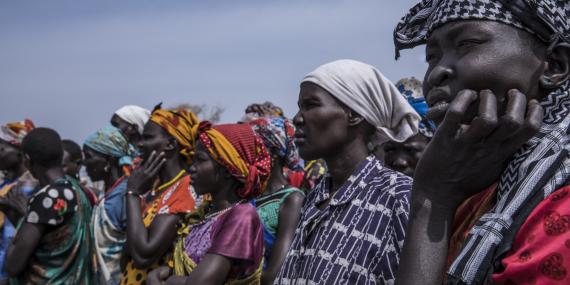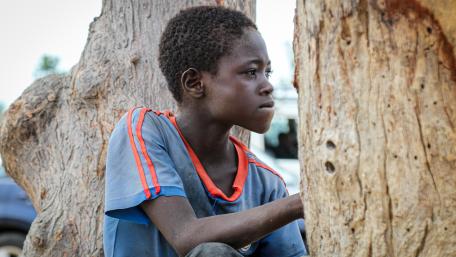Nyal, South Sudan
Embroiled in conflict since 2013, South Sudan is facing a critical humanitarian situation, with chronic hunger and malnutrition affecting families and children in particular. The conflict's longer-term effects have forced tens of thousands of families to remain in temporary shelters and millions of people to seek refuge outside the country. WFP provides life-saving humanitarian assistance in South Sudan, reaching 5 million people across the country. WFP/Gabriela Vivacqua
In East Africa, humanitarian needs are rising and are expected to increase in 2021 due to conflict, climatic shocks, disease and economic challenges.
There are now more than 8.3 million internally displaced people and more than 4.6 million refugees across East Africa, primarily due to conflict and violence in Ethiopia, Somalia, South Sudan and Sudan. The Eastern Route for migration from the Horn of Africa to Yemen and beyond remains the busiest maritime route globally. However, due to COVID-19-related border restrictions and closures, migrants have been stranded in countries with limited access to services and at significant risk of trafficking and exploitation.
Over 31.5 million people were severely food insecure in East Africa at the end of 2020, with concerns that Jonglei State in South Sudan may be at risk of famine. Conflict remains the major driver of food insecurity in the region, but the Horn of Africa desert locust upsurge in 2020 was the worst in 25 years in Somalia and Ethiopia, and 70 years in Kenya. It destroyed agriculture and livelihoods and worsened an already alarming food security situation. The socioeconomic impacts of COVID-19 have also increased pre-existing vulnerabilities, including in Burundi.
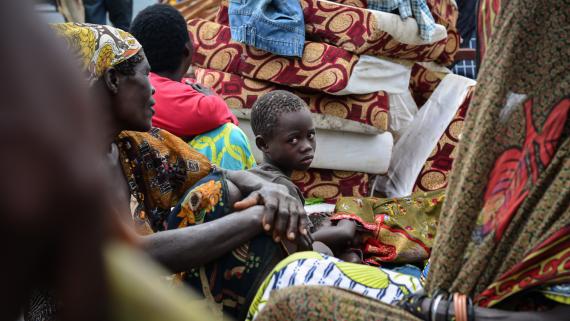
Bujumbura Rural province, Burundi
A boy and his sister, who is suffering from malaria, sit with their family on the side of the road with the few household belongings they were able to rescue from the floods in Bujumbura Rural province.
OCHA/Lauriane WolfeClimatic shocks are compounding the devastation wrought by violence. From June to October 2020, at least 3.6 million people were impacted by floods or landslides across East Africa, many of whom were already suffering due to insecurity and conflict. In Sudan, about 875,000 people were affected by the country’s worst floods in decades, while about 663,000 people were affected in Somalia. In South Sudan, 856,000 people were affected by flooding, including in Jonglei, where people had already been subjected to large-scale subnational violence in 2020. In Ethiopia, about 1.1 million people were affected by flooding in regions where more than 1.1 million had previously been displaced by violence. In addition to the COVID-19 pandemic, the trajectory of which remains uncertain in the region, East Africa is experiencing multiple disease outbreaks including malaria, cholera, polio, chikungunya and viral hemorrhagic fever. Several of these diseases have been exacerbated by above-average rains.
In 2021, East Africa will face significant challenges, which could further increase humanitarian needs. Below-average rains are predicted for the current season and tentatively for the next, which could affect crop production and exacerbate food insecurity in 2021. Elections in Uganda, delicate transitions in Sudan and South Sudan, violence and political uncertainty in Somalia, and the potential for conflict to spread within and beyond Ethiopia could increase protection risks and force more people to flee their homes. The return of Burundian refugees is expected to intensify in 2021, with efforts ongoing to ensure that any movements back to the country are safe, dignified, voluntary and informed.
In Southern Africa, the climate crisis and socioeconomic impact of COVID-19 are deepening existing vulnerabilities, while conflict in northern Mozambique has led to the region’s first major displacement crisis in more than a decade.
Severe food insecurity is affecting 15.9 million people, up from nearly 12 million in 2019. In 2020, the early cessation of rainfall impacted harvests in central and eastern parts of the region. Southern regions that received favourable conditions for agricultural production were impacted by COVID-19 restrictions, resulting in food deficits and price hikes. In other locations, including Zimbabwe, economic challenges contributed to rising food insecurity, while migrants across the region were impacted by COVID-19-related containment measures, with thousands returning from South Africa to Lesotho and Zimbabwe, in particular. At the same time, the African migratory locust outbreak in Southern Africa poses a threat to the 2020/2021 harvest, with about 2.3 million severely food insecure people living in locust-infested areas in the five most-affected countries: Angola, Botswana, Namibia, Zambia and Zimbabwe. Over 2.3 million children and pregnant and lactating women need nutrition support and services across the region, while COVID-19-related containment measures have impacted vital community-based interventions, including screenings.
Southern and East Africa: Overview of appeals
The pandemic has strained already fragile health systems in a region that still has the world’s highest number of people living with HIV. COVID-19 has disrupted routine immunization services and reduced access to critical testing and treatment for tuberculosis and HIV. Malaria is on the rise in Angola, Madagascar, Mozambique, Namibia and Zimbabwe, and there are ongoing outbreaks of measles in Angola and cholera in Mozambique.
Protection risks, particularly gender-based violence (GBV), increased in 2020 due to the economic strain caused by the pandemic. With schools closed for much of 2020, girls are especially vulnerable to their families adopting negative coping strategies, including child marriage, child trafficking and transactional sex. Women faced heightened rates of intimate partner violence and increased exposure to GBV, including when they had to queue for fuel and water. The rise of GBV in the region has increased the risk of HIV transmission.
Evolution of People in Need (2020 vs. 2021)
In Mozambique, conflict in Cabo Delgado escalated rapidly in 2020, causing rising needs. In 2020, displacement tripled from March (110,000) to September (355,000), and more than 400,000 people were displaced by the end of November. Over 90 per cent of internally displaced people are hosted by families and communities, placing strain on their limited resources. Reports of violations against civilians by parties to the conflict have been increasing, including killings and abductions.
Entering 2021, Southern Africa faces the prospect of cyclones, floods, locusts and displacement. The annual cyclone season (November-March) is predicted to bring at least several cyclones to the Indian Ocean, potentially impacting Madagascar and Mozambique. Meanwhile, the conflict in Mozambique is intensifying in scale, scope and complexity and is expected to drive rising needs and displacement into 2021. There have already been cross-border attacks from northern Mozambique into southern Tanzania, which is itself faced with political and human rights challenges that could escalate in 2021.
Further reading
Source: OCHA
Source: OCHA
Burundi
Analysis of the context, crisis and needs
The combined effects of the COVID-19 pandemic as well as climate-related shocks have exacerbated humanitarian needs in Burundi. 2020 was characterized by above-average rainfall in parts of the country, leading to flooding, displacement of people and destruction of harvests. The socioeconomic impacts of COVID-19 have also increased the population’s level of pre-existing vulnerabilities, reversing the downward trend in humanitarian needs observed since late 2018. At the same time, due to the seasonality of cholera and mass distribution of mosquito nets, the number of cholera and malaria cases has reduced significantly during 2020 while measles cases have increased.
Burundi is among the 20 most vulnerable countries in the world to climate change. In late 2019, rising temperatures of the Indian Ocean contributed to an increase in the number and scale of natural disasters in the country. Between October 2019 and October 2020, floods, landslides and other disasters affected 13 of Burundi's 18 provinces. The disasters have also contributed to a 23 per cent increase of IDPs, up from 104,000 in late 2019 to 127,832 in September 2020. Natural disasters account for 83 per cent of internal displacement in Burundi. The effects of climate hazards also continue to impact agricultural production in a context where 90 per cent of the population rely on subsistence farming.
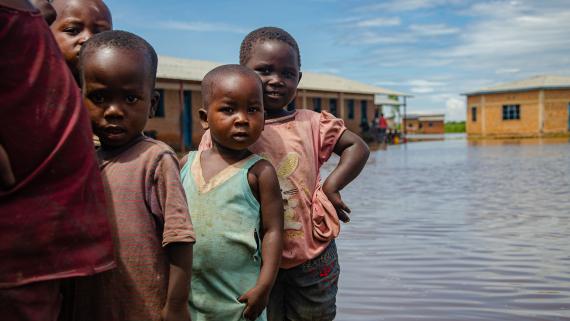
Bujumbura Rural province, Burundi
Children stand in their flooded schoolyard. Their school has become a living space for those displaced by the floods. Nearly 10,000 children have been forced to stop their schooling due to the flooding in Bujumbura Rural province.
OCHA/Lauriane WolfeThe Government has made important efforts to strengthen its capacity in Disaster Risk Reduction, however the pre-existing chronic vulnerabilities, including the fragile economic situation, have impacted its capacity to prepare for and respond to climate-related hazards. Ranked 185 out of 189 on the Human Development Index, Burundi has experienced negative GDP growth over the past five years. The Government has mobilized domestic resources to offset fiscal and balance-of-payments difficulties, but this has been insufficient to meet the continuously rising social demand driven by a high population growth.
Following the newly elected President’s appeal for Burundian refugees to return to the country, the voluntary return of refugees facilitated by UNHCR has increased in recent months. While the number of returnees was relatively limited in 2019 and during the first half of 2020, a considerable increase was noted in the second half of 2020. As a result, 21,769 out of the 28,198 returnees since the beginning of the year were registered between July and 7 November 2020. In addition, the situation of the 78,000 refugees and asylum seekers remains precarious. Nearly 50 per cent of the refugees live in urban areas where the economic situation is fragile while assistance is limited to specific protection cases. For refugees living in camps, there are few job opportunities, resulting in a high dependency on humanitarian assistance.
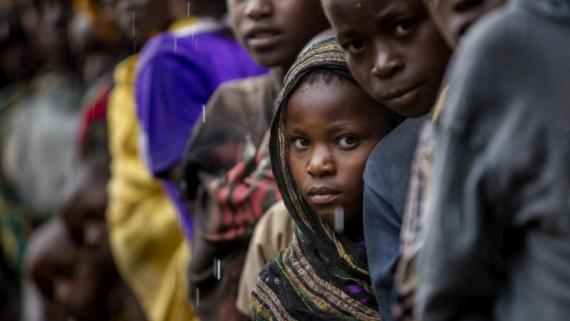
Higiro, Burundi
Burundian returness, who had been living at the Mahama camp in Rwanda, cited the May elections and their desire to return home as resons for signing up to voluntary repatriation. “I learned that there is peace back home so I have to go back and rebuild my life," said one refugee.
UNHCR/Georgina GoodwinBetween January and June 2020, 370,000 (or 42 per cent) of the 887,000 people targeted by the revised HRP were assisted by humanitarian actors, particularly through food and livelihood support and provision of services, including protection and nutrition. Despite these achievements, the low level of funding continues to hamper humanitarian partners’ efforts to meet the needs of the affected people. The most underfunded sectors include shelter and non-food items, education, WASH, protection, and the multisectoral repatriation response.
Projected situation in 2021 and beyond
The socioeconomic impact of COVID-19 and the prevalence of climate-related hazards are expected to continue to contribute to the humanitarian situation in Burundi throughout 2021. This is likely to aggravate pre-existing vulnerabilities. While most of 2020 was characterized by above-average rainfall, the last quarter of the year is expected to be marked by below-average rainfall in half of Burundi, particularly in the eastern and northern parts. According to projections, the lack of rainfall is expected to impact the first cropping season of 2021 and the availability of seeds for future seasons. Combined with the loss of economic opportunities due to decreased cross-border trade following the COVID-19 pandemic, this is expected to increase the number of food insecure people, in IPC phases 3 and 4 from 1.3 million people in October 2020 to 1.9 million people in January 2021.
Evolution of needs and requirements (2016 - 2021)
While average rainfall is expected in the western provinces during the last quarter of 2020 and beginning of 2021, further rain, albeit at normal levels, could lead to further flooding due to saturating groundwater levels in areas affected by the 2020 floods. This could lead to further displacement, heighten the risk of diseases with epidemic potential, such as malaria and/or cholera, and impact crops along Lake Tanganyika. The return of Burundian refugees is expected to intensify in 2021 with 143,000 planned returns (compared to 50,000 in 2020), particularly in Burundi’s eastern and northern provinces. This is also expected to place additional burden on the already vulnerable host communities. Moreover, insufficient donor interest in funding protracted refugee situations could heighten the vulnerability of Congolese refugees in Burundi, particularly those living in camps, where ageing infrastructure needs substantial repair.
Response priorities in 2021
For $196 million, the Burundi HRP 2021 will target 1.04 million people out of an estimated 2.3 million people who need humanitarian assistance. The response will prioritize the most vulnerable populations, particularly returnees, victims of natural disasters including IDPs, and those affected by/at risk of epidemics as well as food insecurity and malnutrition. The priority areas of intervention will include provinces classified at severity level 4 (Cankuzo, Kirundo and Ruyigi) and at severity level 3 (Ngozi, Cibitoke, Bubanza, Kayanza, Bujumbura, Rumonge, Makamba, Rutana, Gitega, Karuzi, Muyinga), as identified during the intersectoral severity analysis.
Further reading
Source: OCHA
Source: Humanitarian Insight
Source: Financial Tracking Service
Ethiopia
Analysis of the context, crisis and needs
Despite positive political developments, in 2020, the population of Ethiopia continues to face uncertainty over political transition due to the ongoing conflict; climate shocks (droughts, floods); desert locust invasion and the ongoing socio-economic impacts of the COVID-19 pandemic. Some of the most marginalized and at-risk population groups have been impacted by multiple shocks, creating an emerging protection crisis. During the Mid-Year Review of the 2020 HRP, the number of people targeted for humanitarian assistance doubled from 7 to 15.1 million.
Since the end of 2017, displacement due to inter-ethnic conflict has emerged as a significant driver of humanitarian needs in Ethiopia. Over the last three years, more than 3 million people have been internally displaced due to conflict. Since 30 September 2020, more than 1.3 million people had either been returned to their areas of origin or relocated to other places. However, durable solutions have in most cases not been attained and residual protection and assistance needs, resulting from their displacement continue, including the need for continued humanitarian assistance. In addition, increased insecurity and localized conflict have not only created protection concerns for the population at large, but have also posed intermittent access challenges for aid workers. At the end of 2020, a conflict between Federal and regional armed forces in Tigray, added a new challenge to the complex humanitarian situation. The conflict is expected to deepen the humanitarian needs of the 850,000 vulnerable people already targeted in the 2020 HRP and generate additional needs.
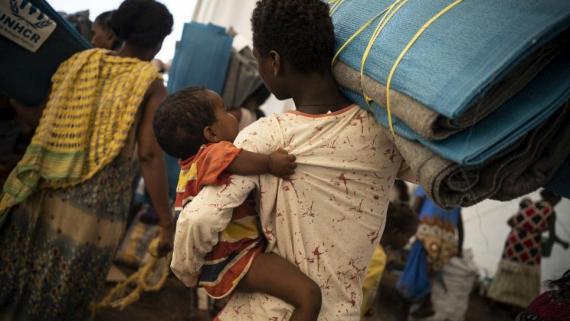
Hamdayet, Sudan
An Ethiopian refugee and her child collect mats at a transit site in Hamdayet, Sudan. The number of Ethiopian refugees streaming into eastern Sudan has now surpassed 40,000 since the crisis began, with more than 5,000 women, children and men fleeing the ongoing fighting in the Tigray region over one weekend. Particularly vulnerable people have been identified and referred to relevant services. Hot meals are being provided and more water points and latrines constructed.
UNHCR/Olivier JobardFloods continue to affect and displace thousands every year. Between June and September 2020, prolonged kiremt rains led to flooding and landslides in six regions. The National Disaster Risk Management Commission (NDRMC) reports in September indicated that about 1 million people were affected and more than 30,000 people were displaced by floods in 2020.
Refugees hosted across the country have been impacted by border closures and travel restrictions as their access to asylum was compromised. In addition, more than 200,000 refugee children have been out of school due to the ongoing pandemic.
Over the last three years, more than 8 million people, on average, were targeted annually with humanitarian food assistance. In 2020 the number of people in need increased to 11.7 million, in part due to the worst desert locust outbreak in 25 years. As of the end of August 2020, the number of children admitted for Severe Acute Malnutrition (SAM) treatment reached unprecedented levels. Over 37,000 SAM children were admitted each month for four consecutive months (13.2% increase in 2020 compared to 2019) and over 1.5 million children, pregnant women and nursing mothers were affected by moderate acute malnutrition (MAM).
Projected situation in 2021 and beyond
The combination and recurrence of multiple, simultaneous, compounded shocks, including conflict, communicable diseases, drought, floods, desert locusts as well as the impact of COVID-19 will continue to put people at risk and undermine their capacity to recover from shocks.
Tensions and conflict may result in continued and further displacement and pose protection risks in different parts of Ethiopia. The run-up to the national elections scheduled for mid-2021 will see deepened ethnic tensions with localized instability and displacement well after the elections.
Changes in the humanitarian context brought about by the COVID-19 pandemic have disproportionately impacted crisis-affected communities. This situation is likely to further deteriorate due to the economic crisis and result in employment losses, not only in Ethiopia but also for migrants who are forced to return home. In 2020, at least 53,490 migrants have been returned to Ethiopia.
Evolution of needs and requirements (2016 - 2021)
Outbreaks of measles and endemic diseases will put further strain on health facilities strained by the pandemic. Coupled with the pandemic, the desert locust invasion has contributed to increased food insecurity and the impact will continue to affect agricultural outputs in 2021 as new generations of desert locusts breed.
Early projections indicate that the spring rains in 2021 will likely be below average with regional drought conditions expected, impacting negatively on crop producers dependent on the Belg as well as on those dependent on long-cycle crops and the Meher.
Lack of livelihoods and inability to meet basic needs leads to an increase in negative coping strategies compounding protection risks, including but not limited, to child labor, early marriage, and transactional sex. In addition, the conflict in Tigray will likely increase protection risks, nutrition/health status, and displacement both within and outside the country.
Response Priorities in 2021
The crisis in Ethiopia is quickly becoming a protection crisis and partners will prioritize protection-related interventions in 2021. Due to the complex context in which Ethiopia finds itself, the humanitarian community will pay particular attention to and ensure the centrality of protection across the response.
Responding to the increasing rate of displacement and the search for durable solutions for those displaced will also be a priority in 2021. A multi-sectoral humanitarian response to the immediate needs of IDPs will include the provision of core relief items to an estimated 1.6 million IDPs, as well as the provision of water, sanitation and hygiene services to more than 710,000 IDPs. This is in addition to a concerted effort towards durable solutions for displaced people.
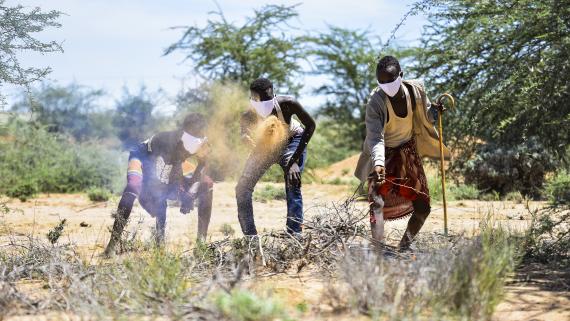
Biyodidley, Ethiopia
A group of farmers tries to make a cloud of smoke, marking their location to an aerial spraying operation. Hoppers have fledged, and an increasing number of small immature and mature swarms have continued to devour crop and pasture fields in Tigray, Amhara, Oromia, and Somali regional states.
FAO/Michael TeweldeAddressing the aggravating impact of COVID-19 on the conditions of people in need of humanitarian assistance will also be a major priority. Mainstream response has encountered a diversion of resources, reduced funding for non-COVID needs, as well as reduced operational capacity due to the impact of the pandemic. The Country Team will among other things prioritize preparedness and response activities including water, sanitation and hygiene services at health facilities and schools to prevent COVID-19 as well as water-borne diseases. Particular attention will be paid to the needs and protection of vulnerable groups such as women, girls, old persons and people with disabilities.
Food insecurity has been a protracted issue in Ethiopia for the past 50 years. Each year, for the last 4 years, approximately 3.4 million people have been chronically dependent on food assistance, A combination of the desert locust invasion, unfavorable impacts of COVID-19, as well as the multiple factors driving humanitarian need and the increasing number of returning migrants, have increased the number of people requiring emergency food and nutrition assistance in both rural and urban communities. An estimated 12.9 million highly food insecure people will be targeted with emergency food assistance. Livelihoods interventions will be prioritized in areas affected by desert locusts.
Nutrition partners will aim at reaching more than 460,000 children affected by severe acute malnutrition to be admitted for treatment and close to 3 million children with moderate acute malnutrition, pregnant women and nursing mothers.
Further reading
Source: OCHA
Source: Humanitarian Insight
Source: Financial Tracking Service
Mozambique
Analysis of the context, crisis and needs
The crisis in Cabo Delgado, Mozambique, has rapidly escalated as a result of conflict, insecurity and violence, leaving an estimated 1.3 million people in need of urgent humanitarian assistance and protection in 2021. Attacks by non-state armed groups expanded geographically and increased in intensity in 2020, significantly heightening protection risks, especially for women and girls, people with disabilities, older persons and people living with HIV/AIDS. Reports of violations against civilians by non-state armed groups, including killings, beheadings and kidnappings, increased in 2020, and there were allegations of abuses by government forces.
The number of people displaced by the crisis more than quadrupled from March (110,000) to November 2020 (over 500,000), with children accounting for an estimated 45 per cent of people displaced. More than 90 per cent of displaced people are staying with family and friends in host communities’ whose already meager resources are being strained by the growing influxes: in Ibo district, there are now more IDPs than host community members; in Pemba city, more than 100,000 displaced people have arrived over the past year, on top of the original population of around 224,000 people. Meanwhile, 10 per cent of displaced people are staying in collective sites which are overcrowded, lack privacy, and have limited access to safe shelter, water and sanitation. This is contributing to protection risks, including gender-based violence, rising numbers of child and teen pregnancies, and increased exposure to exploitation and negative coping mechanisms, including transactional sex.
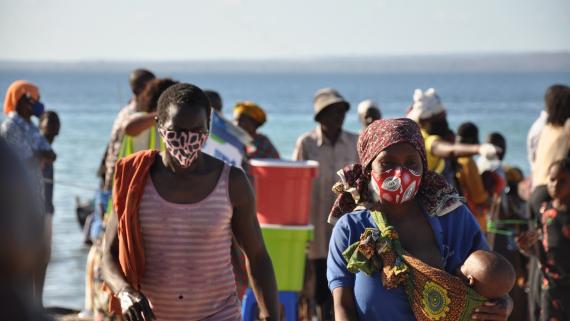
Pemba, Mozambique
A group of displaced people arrives at the Pemba port, having left their belongings behind. Around 390,000 people have been displaced in Cabo Delgado, one of the poorest parts of the country of 30 million people. Aldeias, Portuguese for villages, are often attacked during the early morning hours. Those fleeing must often abandon their homes without any warning. They are frequently on foot, with no food, water, money, documents or clothes.
WFP/Sean RajmanHealth, WASH and Education services across Cabo Delgado -which were already stretched- have been significantly impacted by the escalating violence. Insecurity has damaged or destroyed 36 per cent of health facilities across Cabo Delgado province and there are no functional health facilities in the districts hardest hit by conflict (Mocomiboa da Praia, Macomia, Muidumbe and Quissanga). This has reduced the capacity to detect and respond to disease outbreaks, including cholera, measles and COVID-19. It has also affected the provision of critical care, such as sexual and reproductive healthcare, immunization activities, access to anti-retrovirals (ARVs) and treatment for tuberculosis (TB). At the same time, an estimated 176,000 people have lost access to their primary water source due to disruption of services from centralized water supply networks as a result of conflict. Lack of access to safe water and hygiene facilities is a major concern and heightens the risk of disease outbreaks: 45 per cent of health facilities in Cabo Delgado lack access to water and 85 per cent of schools lack adequate hygiene facilities.
Food insecurity is rising as conflict and repeated displacement, compounded by climatic shocks, have disrupted communities’ agricultural activities and livelihoods. More than 900,000 people in Cabo Delgado, Niassa and Nampula are now facing Crisis or Emergency levels of food insecurity (IPC Phase 3 and 4), while disruption of markets due to insecurity has driven up the cost of food and household items.
Projected situation in 2021 and beyond
Humanitarian needs and displacement in the northern provinces of Cabo Delgado, Niassa and Nampula are expected to rise in 2021 due to the compounding effects of extreme climatic events and increasing violence and attacks in Cabo Delgado. Violence and attacks are expected to lead to new waves of displacement and violations against civilians. Displaced people are likely to continue looking for safety in the southern districts of Cabo Delgado province and, increasingly, the neighboring provinces of Nampula and Niassa provinces. This will place further strain on already over-stretched health, WASH and education system, and will continue to drive food insecurity in 2021.
Evolution of needs and requirements (2016 - 2021)
The Government of Mozambique has indicated that it intends to relocate people arriving into these areas into formally established resettlement sites, which will themselves require significant attention and action by international partners to ensure that they meet minimum emergency response standards and that any population movements are safe, dignified, voluntary and informed. At the same time, communities will likely be faced with climatic shocks -especially flooding- which will negatively impact displaced people already struggling to survive and challenge the ability of humanitarian partners to reach people in need, while keeping people off from access to essential services, as was seen during January 2020. At the same time, communities will be struggling to cope with the additional socio-economic strain caused by the COVID-19 pandemic, weakening their capacity to withstand shocks and pushing increasing numbers of households to adopt negative coping mechanisms.
Response priorities in 2021
In 2021, humanitarian partners will require $254.4 million to assist 1.1 million people out of an estimated 1.3 million people in need of humanitarian assistance. This represents a significant increase from the $35.5 million requested under the Rapid Response Plan developed for Cabo Delgado in May 2020, which is commensurate with the manifold increase in humanitarian needs from the beginning to the end of 2020.
In order to galvanize targeted resources and action to respond to the most severe needs in the country, the 2021 Mozambique HRP focuses solely on the three northern provinces affected by conflict, violence, insecurity and displacement: Cabo Delgado, Niassa and Nampula. Within these provinces, humanitarian partners will implement multi-sectoral responses for people displaced by the violence and vulnerable host communities in need of protection, food security, nutritional support and access to safe water, healthcare, education and shelter.
The HRP has been robustly prioritized. Each sector has reviewed all of the projects proposed by their partners to ensure that they are aligned with the cluster and overarching response priorities, provide value-for-money, and tackle cross-cutting issues, including gender, protection, accountability to affected people and the prevention of sexual exploitation and abuse. In addition, an inter-cluster review was held to ensure complementarity, avoid duplication and promote multi-cluster action to address issues that require more than a single cluster response.
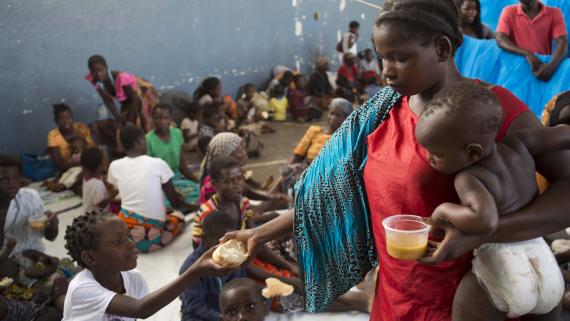
Buzi, Mozambique
Children receive food provided by a supermarket chain at the Samora Machel school, where they were brought after their homes were destroyed and flooded in Buzi, Mozambique.
UNICEF/Karel PrinslooGiven the highly complex operating environment, the HRP includes a strong common services component, including for logistics, coordination, security and community engagement. As the context is rapidly evolving, humanitarian partners will continue to identify adaptable, appropriate and effective approaches to access the most vulnerable in ‘hard-to-reach’ locations, including through rapid and mobile response to ensure assistance in areas where humanitarians are unable to maintain a consistent presence.
Listening, and responding, to the voices of affected communities will be a core tenet of the Mozambique humanitarian response. This will also include activities to prevent and respond to sexual exploitation and abuse, in line with the humanitarian community’s clear zero-tolerance policy.
Further reading
Source: OCHA
Source: Humanitarian Insight
Source: Financial Tracking Service
Somalia
Analysis of the context, crisis and needs
Somalia’s prolonged humanitarian crisis is characterized by ongoing conflicts, climate shocks including floods and drought, communicable disease outbreaks and weak social protection. Since the beginning of 2020, two additional shocks have contributed to a deterioration of humanitarian conditions: the desert locust infestation and the COVID-19 pandemic.
Flooding displaced 840,000 people in the first 10 months of 2020 and destroyed infrastructure, property, and 144,000 hectares of agricultural land. Somalia also experienced the worst desert locust invasion in 25 years; tens of thousands of hectares of cropland and pasture were damaged, with potentially severe consequences for agriculture and pastoral-based livelihoods.
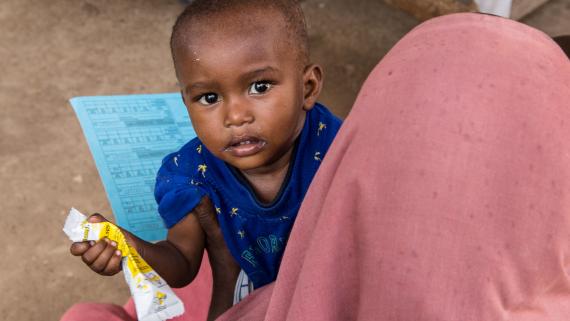
Barderee, Somalia
Women queue for food supplies at a Mother Child Health and Nutrition centre in Barderee, Gedo region. The programme aims to treat moderately malnourished children and women. WFP carried out a pre-drought assessment to better understand the situation on the ground, and works with partners and authorities in Somalia to provide food assistance to vulnerable households.
WFP/Kevin OumaCommunities living in conflict areas were severely impacted by armed violence. Civilians bore the brunt through death and injury, property destruction, taxation of communities (including through forced child recruitment), land grabbing, destruction of livelihoods, limited freedom of movement, and limited access to services and humanitarian assistance.
COVID-19 directly impacted the lives of Somalis, worsening patterns of vulnerability. This came on top of ongoing disease outbreaks such as cholera, measles and, recently, vaccine-derived poliovirus. Health-care providers have faced increased burdens and costs, forced to alter the way care is provided. Restrictions also disrupted the face-to-face delivery of humanitarian assistance, impacting assessments, targeting and the quality of the response. However, partners successfully scaled up mobile money transfers and transitioned to assessments via mobile phones.
The number of people in need has consistently increased over the last three years, from 4.2 million in 2019 to 5.2 million in 2020 and 5.9 million in 2021. This is further reflected in the number of displaced people in 2020: 1.2 million. This is the highest number over the past three years, with 884,000 in 2018 and 770,000 in 2019. Other factors, such as gender, age and disability, add to the level of vulnerability, risks and barriers faced. As such, they need to be considered in the humanitarian response.
Projected situation in 2021 and beyond
Based on the risk analysis, it is highly likely that climate shocks will continue to affect the most vulnerable people in Somalia in 2021. Drought conditions are expected in early 2021 as La Niña is likely to cause decreased rainfall in the Deyr rainy season (October-December), affecting crop production. Given the fragility of food security in the country, this will likely have a devastating impact well beyond the beginning of 2021. Further, despite ongoing control measures, there is a high likelihood that conditions will remain favorable for locusts to continue breeding and developing, increasing food insecurity and the effects on livelihoods.
Recent climate events show that even during drought conditions, heavy and localized rains are likely to cause damage and displacement. Flooding is expected to occur again during the 2021 Gu rainy season (April-June). However, it may not be as severe as in 2020. The number of people affected by flooding has increased significantly in recent years, with 840,000 displaced in 2020, 416,000 in 2019 and 281,000 in 2018.
Evolution of needs and requirements (2016 - 2021)
The COVID-19 pandemic, along with other communicable diseases and an ongoing outbreak of cholera, will continue to affect the most vulnerable Somalis and strain the already weak health system. According to a WHO global estimate, 20 per cent of Somalia’s population will suffer from the direct and indirect impacts of the pandemic in 2021.
Armed conflict and insecurity are expected to continue to drive needs and cause displacement while simultaneously impeding effective humanitarian operations and access to vulnerable or marginalized communities. Due to the security situation in Yemen and sporadic instabilities in Ethiopia, it is expected that Somalia will continue to receive refugees and asylum seekers. Over 28,000 refugees and asylum seekers are projected to require assistance and support in 2021.
Response priorities in 2021
Despite operational and access challenges, humanitarian partners reached over 2.3 million people out of 3 million targeted in 2020. For 2021, humanitarian partners anticipate an increase in the number of people in need, driven by climate shocks, conflict and increased vulnerability. The aim, therefore, is to assist 4 million people, including IDPs, refugees and returnees, with access to basic services and livelihoods support, while providing life-saving food assistance to 3.1 million IDPs and non-IDPs in crisis and emergency phases of food insecurity.
Operationalizing humanitarian-development-peace collaboration
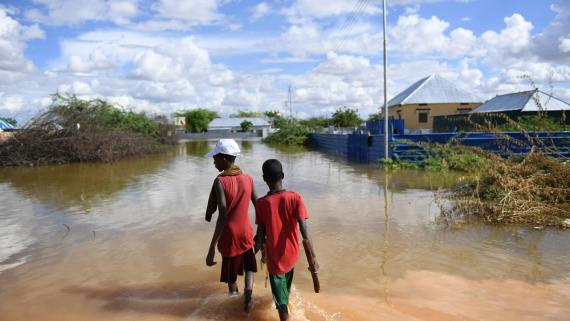
Significant strides were made in 2020 to operationalize the humanitarian-development-peace nexus in Somalia. Led by the Integrated Office of the DSRSG/RC/HC and OCHA under the guidance of the RC/HC, a high-level Nexus Steering Committee is being established informally alongside the Somalia Aid Architecture. The committee will provide advice and direction for the successful implementation of the nexus. On the ground, humanitarian and development actors are making progress on coordinating flood response, mitigation and preparedness measures. Devastating floods are becoming more intense and frequent in Somalia, exacerbated by climate change and causing recurring displacement, income loss and property damage. The response led by the Government, local authorities and the international community addresses the most urgent needs. However, more focus is needed on root causes and longer-term development to enable a sustainable solution. A Water and Flood Task Force was formed, bringing together humanitarian and development actors, including Government officials and donors, to develop a road map on flood response. It aims to improve humanitarian-development coordination, assess future flood response priorities, and identify best practice opportunities on flood mitigation and river management. This will include a coordinated approach to determine whether activities sit under the HRP or the UN Cooperation Framework.
UN Photo/Ilyas AhmedA key response priority is to ensure that 2.8 million people receive critical, life-saving assistance so their health, nutrition and short-term capacity to survive are not compromised. Children under 5 years of age, vulnerable women and persons with disabilities are among the most vulnerable in IDP and non-IDP populations.
The lack of protection from violence, abuse and neglect remains an important consequence of the current humanitarian crisis for up to 4 million people. The centrality of protection is therefore a key priority across the humanitarian response, including strengthening the overall protection environment for all affected populations via protection mainstreaming, accountability to affected populations, human rights and eviction monitoring.
Further reading
Source: OCHA
Source: Humanitarian Insight
Source: Financial Tracking Service
South Sudan
Analysis of the context, crisis and needs
As the humanitarian crisis in South Sudan enters its eighth year, approximately two thirds of the population need some form of humanitarian assistance. Years of conflict, subnational violence, food insecurity, severe flooding and now the COVID-19 pandemic have led to increased vulnerabilities among the population.
More than 1,500 people were killed and over 157,000 displaced because of subnational violence during the first half of 2020. Women and children have been abducted, and more than 6,000 GBV incidents were recorded between January and September 2020.
Food insecurity persisted for communities across the country. At least 6.5 million people were acutely food insecure during the 2020 lean season. Households were negatively impacted by COVID-19, and the economic shocks linked to the depreciation of the South Sudanese pound, which resulted in drastic increases in food prices. Between August and mid-September 2020, the cost of a food basket increased by 42 per cent. An estimated 1.3 million children and 350,000 women were acutely malnourished in 2020.
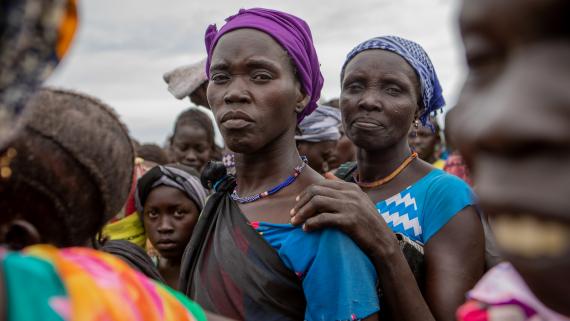
Pibor, South Sudan
Community members wait for an NGO distribution of non-food items, including blankets and tarpaulin, following devastating floods in Pibor, Jonglei.
UNICEF/Maria de la GuardiaRepeated displacements triggered by violence and flooding in 2020 occurred in locations already experiencing multiple crises, such as Jonglei State and Greater Pibor Administrative Area. Flooding has affected an estimated 800,000 people across almost half of South Sudan’s counties and temporarily displaced nearly 400,000 people.
The country continues to struggle with disease outbreaks due to low immunization coverage, a weak health system and poor hygiene and sanitation. Illnesses such as malaria and waterborne infections continue to impact people. The COVID-19 outbreak increased pressure on the limited health services and disrupted learning. More than 2.2 million children are out of school, with girls disproportionately affected.
People have an increased vulnerability to waterborne diseases, given the vast geographic areas impacted by floods, with an elongated rainy season. Access to health-care services will remain a challenge for many people, with 44 per cent of the population living within 5 km of a health facility.
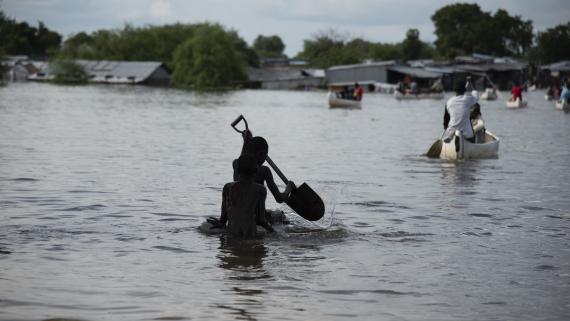
Pibor, South Sudan
Children in Pibor build their own boat from tarpaulin and plastic bottles. A spade is used as an oar. Early and heavy seasonal rain caused flooding in several parts of South Sudan, with Upper Nile, Lakes and Jonglei being hardest hit. Humanitarian partners are responding to the floods by ensuring access to clean water and sanitation and continuation of essential services such as nutrition and health, including immunization. They are also providing child protection services, including family tracing and reunification. Schools will soon reopen after being closed due to COVID-19. A safe reopening assessment will be carried out for schools, also in areas where schools are damaged by floods or used as shelters.
UNICEF/Helene RyengSome 1.6 million people are internally displaced. The majority (75 per cent) live in host communities, with the remaining 25 per cent in camp-like settings, including Protection of Civilians (PoC) sites and IDP camps. More than 2.2 million South Sudanese refugees are seeking refuge in the region, with the main outflow in 2020 attributed to insecurity, flooding and food shortages in potential return areas. Some 1 million IDPs and 285,000 refugees have spontaneously returned, and many remain vulnerable due to a lack of access to services, shelter and protection.
Humanitarian access deteriorated in 2020, with repeated acts of violence against humanitarian workers and humanitarian assets. Between January and September 2020, approximately 450 violent incidents against humanitarian personnel and assets were reported. Nine humanitarian workers were killed while delivering life-saving humanitarian assistance between January and October 2020.
Despite these challenges, 5.6 million people received food assistance and livelihoods support, and 1.1 million children and new mothers received nutrition services. More than 3.6 million health consultations were conducted in 2020.
Projected situation in 2021 and beyond
Conflict, economic crisis, flooding and disease outbreaks will remain key drivers of humanitarian needs in South Sudan. Limited progress in the peace agreement and political and security tensions are expected to continue in 2021. Anticipated subnational violence will cause more displacement and increase humanitarian needs. Protection issues, including GBV, remain a concern. It is expected that the IDPs will remain in the newly transitioned IDP camps (formerly PoC sites) and host communities because of a lack of basic services in their areas of origin.
Evolution of needs and requirements (2016 - 2021)
Food insecurity is anticipated to deteriorate in 2021 compared to 2020, driven by insecurity, COVID-19 impacts, floods, continued economic crisis, and sharp increases in food prices. The number of South Sudanese people who will need food assistance at the peak of the lean season in 2021 is estimated to increase substantially, pending IPC findings. The highest levels of food security are concentrated in areas affected by recurring shocks, such as violence and floods, including in Jonglei, Upper Nile, Unity, Lakes and Warrap states. Limited availability of and access to basic WASH services and poor vaccination coverage are likely to cause disease outbreaks as COVID-19 continues to put additional pressure on an overstretched health system. Humanitarian organizations will face increasing access constraints, including bureaucratic impediments affecting their ability to effectively respond to people’s needs.
Response priorities in 2021
In 2021, the humanitarian response will be guided by three overall strategic objectives: i) to reduce morbidity and mortality among vulnerable populations; ii) to facilitate access to cross-sectoral basic services; iii) to enable populations to cope with repeated shocks and find solutions to displacements. Centrality of Protection will be at the core of the response, including the prevention of and response to GBV.
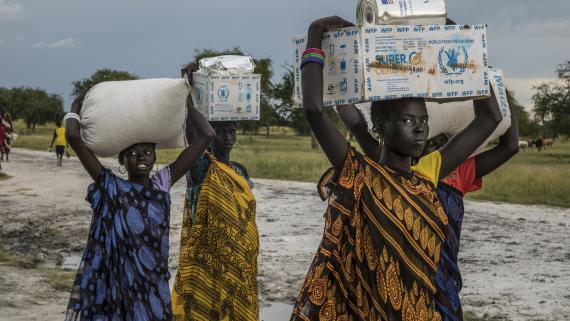
Thaker, South Sudan
A family carries away the food assistance they received at an emergency distribution point in Thaker, Unity state. WFP provides cereals, vegetable oil, salt, pulses and where necessary, nutrition supplements to prevent and treat undernutrition among children and pregnant and nursing women.
WFP/Gabriela VivacquaAs the humanitarian crisis continues, resources are falling short of what is required to adequately respond to increasing needs. Funding levels for the 2020 appeal are low compared to the same period last year. As of 24 November, the HRP and its COVID-19 addendum requesting $1.9 billion were 51 per cent funded. Responding to people’s needs while mitigating and preventing the onward transmission of COVID-19 will increase the cost of care. The multiple drivers of needs that compound each other will require more resources to support an agile and timely response.
Further reading
Source: Humanitarian Insight
Source: Financial Tracking Service
Sudan
Analysis of the context, crisis and needs
The continuing political transition has opened opportunities for peacebuilding and international engagement. However, humanitarian needs have continued to rise, driven by an economic crisis, COVID-19, record flooding levels, localized conflict and disease outbreaks.
During 2020, there has been some progress towards addressing the economic crisis. An international conference secured pledges of financial support, including for a cash-transfer programme; the IMF began a programme to support economic reforms; and the United States Government announced the intention to remove Sudan from the State Sponsors of Terrorism List, an impediment to securing debt relief and international finance. However, this support is not yet sufficient to allow for economic reforms while mitigating the impact on vulnerable people. The economy has continued to deteriorate, exacerbated by the socioeconomic impact of COVID-19, with rising inflation, fuel and medicine shortages, and soaring food prices.

Mandela Mayo, Sudan
This 50-year-old widow is the mother of 3 daughters and grandmother of 10 children. She lives with two of her daughters and eight grandchildren, as well as two cousins. Her home was partly destroyed due to heavy rain during the floods. Her husband died years ago, and she is the only person who generates income in the family by washing clothes.
OCHA/IndeepvisionConflict remains lower than the levels of 2016 and earlier. In 2020, the Government reached a peace agreement with several armed groups in Darfur, Blue Nile and South Kordofan (the Two Areas), though two key groups who control certain parts of the country have not yet signed this agreement. Still, several incidents of violence in Darfur, South Kordofan and eastern Sudan close to 100,000 people. Protection concerns remain a core driver of humanitarian needs in the country. While the peace process may open opportunities for durable solutions, these are yet to be found. Millions of people continue to live in protracted displacement inside and outside the country as refugees.
Military escalation that started on 3 November in Ethiopia (Tigray region) resulted in a refugee influx into East Sudan. As at 22 November 40,277 Ethiopian refugees have crossed the border into Sudan, up from 146 individuals on 9 November. Humanitarian partners, under the leadership of UNHCR, are planning to respond to 100,000 arrivals from Ethiopia over six months and developing a contingency plan for 200,000 for the same period.
Renewed outbreaks of malaria, polio, chikungunya and viral hemorrhagic fever continue. A rise in the number of COVID-19 infections is putting additional pressure on an already weak health system. 2020 also saw the worst episode of flooding in decades, affecting nearly 900,000 people, damaging houses, and causing losses of livelihoods and agricultural production.
Projected situation in 2021 and beyond
A total of 13.4 million people (over a quarter of the population) are projected to need humanitarian assistance in 2021. This represents a one-third increase from 2020 and the highest level in a decade. About 7.3 million people will need emergency assistance for life-threatening needs, while 13 million people will need humanitarian services because living standards are so low. The highest needs include health, water and sanitation, and food security. A total of 7.8 million of people in need are women and girls. Particularly vulnerable groups include 2.5 million IDPs and 1.1 million refugees, mostly from South Sudan. Just over half of people in need are in the conflict-affected states of Darfur and the Two Areas, which have the highest rates of food insecurity. But the largest increases in people in need have been in the east and the center, driven by the economic crisis. Protection concerns will remain prominent, with a higher impact on the most vulnerable people.
Evolution of needs and requirements (2016 - 2021)
Drivers of need are likely to persist into 2021. Gaining access to debt relief and IFI financing will take time. Economic reform efforts remain at risk, as donor support is not yet at the level to mitigate potentially painful impacts on the population. The economic situation is likely to limit improvements to health systems, with significant disease outbreaks likely to continue as progress addressing protracted displacement will require significant investment in development and services. Significant flooding is likely to reoccur, if not at 2020 levels.
Beyond 2021, the evolution of needs will depend on the economic crisis, the stability of the political transition, the peace process, and international economic and development support. The Juba Peace has re-set the clock on the transition – to January 2024 – with handover from the military in July 2022. It allows its signatories to run for office in the future and gives them a place in the executive. Significant humanitarian needs are likely to persist in the medium term.
Response priorities in 2021
As needs have increased, humanitarian organizations have scaled up assistance despite operational challenges posed by COVID-19 and the economic crisis. But funding gaps remain. Improvements in humanitarian access under the civilian transitional Government – including to areas under the control of non-State armed groups – have facilitated aid delivery. While funding for humanitarian operations in 2020 reached the highest level since 2011, it did not keep pace with the growth in needs, resulting in a larger funding gap than in 2019. Overall, humanitarians reached 8.8 million people in 2020 with some form of assistance. A total of $1.8 billion is required to support the humanitarian response in 2021. The 2021 HRP is based on activity-based costing, and premised on the number of people to be targeted.
Improving financial planning

In 2021, the Sudan HRP transitioned from using exclusively project-based costing to a hybrid approach to calculate its financial requirements. This hybrid approach includes a combination of activity-based costing to project registration. This HCT-endorsed process seeks to harmonize partners’ approaches on budgeting for humanitarian interventions, based on activities that are common within each sector. Using sector-specific methodologies, in collaboration with partners, each sector has agreed on a set of activities, goods and services packages for each sector, which they will implement under the 2021 HRP. Sectors have established ranges of cost per activities, which provides them with operational flexibility in a context with high inflation and changing operational costs. The hybrid approach increases transparency on the calculation of financial requirements per sector, and it allows them to directly link the type of activity with the number of people targeted in each sector to draw an estimation of the total cost per sector. The activities are used to inform project registration, which will still allow for financial tracking under FTS.
OCHA/IndeepvisionIn 2021, the HRP will prioritize life-saving multisectoral assistance in areas with the highest convergence of severity of needs, including response readiness for recurring flooding, conflict and disease outbreaks. Partners will scale up food assistance, disease prevention and response, and emergency response to people newly displaced by conflict or flooding. The response will also prioritize life-sustaining services, such as essential health services (including vaccination and antenatal care), surveillance and response to waterborne and vector borne diseases, education, livelihood opportunities, water and sanitation, supplemental nutrition and school feeding, aiming to avoid further deterioration.
Finally, the HRP will prioritize the rights-based approach to protection needs, particularly in Darfur where the UNAMID peacekeeping mission is set to close. The modus operandi of humanitarian aid delivery will, as possible and appropriate, support building community capacity to sustain durable solutions and promote social peace.
Further reading
Source: Humanitarian Insight
Source: Financial Tracking Service
Source: OCHA
Zimbabwe
Analysis of the context, crisis and needs
In 2021, 6.8 million people will need humanitarian assistance in Zimbabwe, primarily due to climatic shocks and prevailing macro-economic challenges, compounded by the COVID-19 pandemic. Over the past year, the cost of basic commodities has significantly increased. Poverty is estimated to have affected at least 47 per cent (7.6 million people) of the country’s population in 2020, up from 40 per cent (6.6 million people) in 2019. Women, who constitute 65 per cent of the informal sector, are disproportionately affected by economic hardship.
Following relatively good 2019/2020 seasonal rains and a major scale-up in food assistance, there was a reduction in severe food insecurity in 2020 compared to 2019. However, nearly 3.4 million people in rural areas are projected to face Crisis or Emergency (IPC Phase 3 or above) food insecurity during the 2020/2021 lean season (January-March) and 2.3 million people in urban communities are projected to be food insecure in 2021. Households saw an average 51.5 per cent reduction in income in 2020 compared to 2019, according to the ZimVAC. An estimated 1.2 million people in IPC Phase 2 (Stressed) would be at least one phase worse were it not for ongoing assistance. It is vital that this assistance be continued throughout the 2020/2021 lean season.
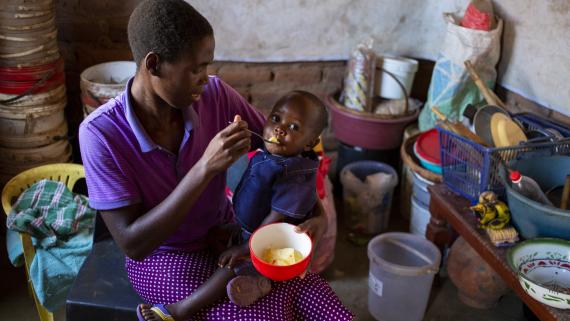
Mutare, Zimbabwe
A mother feeds potatoes to her 19-month-old son, Freedom, at her home next to the Tanganda Rural Health Centre near Mutare, Zimbabwe. Freedom was suffering from malnutrition but has been receiving plumpy’nut supplement and is recovering well. Southern Africa, including Zimbabwe, is experiencing a severe drought. Eastern parts of Zimbabwe are worst affected as they are suffering from the effects of crop destruction by Cyclone Idae last year and the drought this year. For two consecutive seasons, farmers were hardly able to plant crops.
UNICEF/PrinslooZimbabwe saw a sharp increase in protection concerns during the COVID-19 lockdown, including gender-based violence, in 2020. From January to September 2020, 5,507 GBV cases were reported through the National GBV Hotline, a 200 per cent increase compared with the same timeframe in 2019.
Children have been uniquely impacted by the prevailing humanitarian situation. Over 4.6 million children lost access to education and referral mechanisms provided in schools, while over 1.7 million children lost access to school feeding programmes. The humanitarian situation in Zimbabwe has caused a decrease in quality dietary habits, while access to nutrition services has been disrupted. Distressed households have reported increased use of negative coping mechanisms including child labor, early marriage and transactional sex, while economic challenges are creating barriers for children’s return to education, especially for girls.
Projected situation in 2021 and beyond
The Zimbabwean economy remains unpredictable and inflation is likely to continue in 2021. In 2020, month-on-month inflation peaked at 35.53 in July, while year-on-year inflation peaked at 785.6 per cent in May. The stressed macro-economic environment is unlikely to improve in the immediate-term and is expected to negatively impact on household livelihoods, incomes and access to basic commodities, as highlighted in the 2020 ZimVac.
Forecasts of rain offer a more positive outlook for the 2020/2021 season, crop production is expected to improve and efforts are underway to boost agricultural production, including through conservation agriculture methods (“Pfumvuzda”). However, production will remain 30 per cent below the five-year and ten-year averages and multiple risks could negatively impact the 2020/2021 harvest, including the African Migratory Locust outbreak. The forecasted above-average rainfall could create a favourable breeding environment for an outbreak and swarms and hoppers are already seen in Manicaland Providence and Hwange. If uncontrolled, locust damage to crops would have a multiplier effect on food insecurity in communities already affected by previous droughts and COVID-19.
Evolution of needs and requirements (2019 - 2021)
Disruptions to critical services -including Child Protection, Education, Health and WASH- are likely to persist, due to floods, drought, COVID-19, prevailing economic challenges, potential industrial action by critical civil servants and power outages. The economic situation has constrained access to reproductive healthcare and the pandemic is straining aging health infrastructure. Power cuts have disrupted care for critically-ill patients and essential drugs and commodities have faced stockouts. Average to above-average rainfall -forecast for the 2020-2021 rainy season- and worsening access to clean water and appropriate sanitation, could increase the risk of water-borne disease outbreaks, particularly during the first half of 2021.
Response priorities in 2021
The 2021 Zimbabwe Humanitarian Response Plan calls for $505.5 million to provide life-saving and life-sustaining assistance to nearly 4.5 million people out of the estimated 6.8 million in need. In consultation with the Government of Zimbabwe, the HRP prioritizes response to floods, drought, COVID-19 and the prevailing economic situation. The 2021 portfolio of projects has been robustly prioritized through a two-step process. Clusters undertook intensive sectoral reviews of planned activities against the severity of needs and partner capacity. They then reviewed each other's proposals to remove duplication and promote synergies in tackling critical issues that require multi-sectoral response (e.g. gender-based violence, malnutrition, disease outbreaks). This also allowed them to collectively and effectively tackle cross-cutting issues, including the centrality of protection, gender-sensitive response and the prevention of sexual exploitation and abuse.

Epworth, Zimbabwe
A boy smiles while playing on a mound of sand in Epworth, Harare, one of the areas hardest hit by food insecurity in Zimbabwe.
OCHA/Jayne Tinashe MacheThe reduction in financial requirements from 2020 to 2021 reflects this rigorous process, rather than a reduction in the scale of the crisis. It was also an intensive effort, undertaken in close coordination with development actors, to determine which activities will go into the HRP, versus those to be incorporated into development frameworks, including the new United Nations Strategic Development Cooperation Framework. Lastly, cash-based programming was incorporated into the HRP, wherever feasible.
Further reading
Source: OCHA
Source: Humanitarian Insight
Source: Financial Tracking Service
References
- According to the ND-GAIN Country Index, Vulnerability and Readiness.
- Provisional figure. Consultations with the Government are ongoing.
- As of 30 of September IOM reported 53,490 returned migrants to Ethiopia in 2020.
- Human Rights Division, United Nations Mission in South Sudan, Quarterly Brief on Violence Affecting Civilians, April–June 2020
- Figures for People in need, People targeted and Requirements are pending the finalization of the 2021 HNO and HRP.

